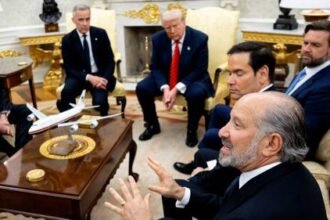Global markets tumbled Tuesday as escalating tensions between the world’s two largest economies sent investors rushing toward safe-haven assets. The Dow Jones Industrial Average dropped over 400 points while the S&P 500 and Nasdaq Composite both fell more than 1.5%, marking their worst single-day performance since early March.
The selloff came after President Biden announced plans to raise tariffs on $18 billion worth of Chinese imports, including electric vehicles, lithium-ion batteries, and critical minerals. The administration characterized the move as necessary to counter China’s “unfair trade practices,” but Beijing quickly condemned the action as “economic coercion.”
“We’re witnessing the collision of economic policy and national security concerns in real-time,” said Marcus Reynolds, chief investment strategist at Capital Insights. “Markets hate uncertainty, and right now, there’s no clear endgame to this trade dispute.”
Technology stocks bore the brunt of the downturn, with semiconductor manufacturers particularly vulnerable given their significant exposure to Chinese markets. Nvidia shares plunged nearly 6%, while Advanced Micro Devices and Intel fell 4.8% and 3.7%, respectively.
The implications extend beyond Wall Street. American consumers could face higher prices for electronics and vehicles if tensions continue to escalate. Meanwhile, manufacturers with complex supply chains spanning both countries are scrambling to assess potential disruptions.
“Companies have spent years building integrated global supply chains,” explained Jennifer Wu, supply chain analyst at Global Research Partners. “Unwinding these connections isn’t something that happens overnight without significant costs being passed on somewhere.”
China’s Commerce Ministry issued a stark warning that it would “take all necessary measures to firmly defend its legitimate rights and interests,” suggesting retaliatory actions may be forthcoming. Chinese state media outlets characterized the tariffs as a politically motivated attempt to contain China’s economic rise.
The volatility wasn’t limited to equities. Gold prices jumped 1.2% to $2,336 per ounce as investors sought traditional safe havens. The dollar strengthened against most major currencies, while U.S. Treasury yields declined as capital flowed into government debt.
Energy markets also reacted sharply, with oil prices dropping over 3% on fears that escalating tensions could dampen global economic growth and reduce demand. This ripple effect demonstrates how deeply intertwined the U.S. and Chinese economies remain despite years of “decoupling” rhetoric.
“We’re entering a new phase of great power competition that’s playing out across economic, technological, and security domains,” noted Dr. Eliza Chen, international relations professor at Pacific Northwest University. “Markets are only now beginning to price in the long-term implications.”
For investors, the path forward appears increasingly uncertain. Many analysts are advising clients to prepare for prolonged volatility as both nations seem willing to accept economic pain to achieve their strategic objectives.
As Washington and Beijing continue their high-stakes economic brinkmanship, one question remains paramount: How much economic disruption are both sides willing to tolerate before seeking compromise? The answer may determine not just market performance in the coming months, but the shape of the global economy for years to come.







